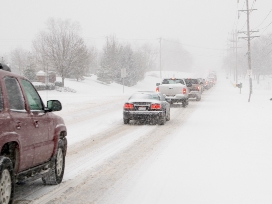Prepare for Slick Conditions
Precipitation and freezing temperatures can form icy, dangerous surfaces on roadways and sidewalks. A long freeze can cause icicles, posing a safety and structural hazard to you, your home, buildings and other objects where ice forms.
Be alert for ice dangers and prepare ahead of time for the chance of a freeze.
At Your Home
-
Sprinkle ice melting products on all walkways, steps and driveways before and after a freeze to prevent slips and falls.
-
Beware of ice dams, a buildup of ice at the lower edge of a sloped roof, usually at the gutter. Keep your attic well ventilated and cold for a lesser chance of melting and refreezing snow and ice on the roof. Ensure the attic floor is well insulated to minimize the amount of heat rising through the attic from within the house.
-
Protect your pipes from freezing by insulating those that are on the exterior and exposed. Drain all garden hoses and air conditioner pipes to eliminate the potential of water freezing and causing damage.
In Your Vehicle
-
If you do not have to drive in bad weather, don’t.
-
If you must go out in icy conditions, decrease your speed and leave plenty of room to stop.
-
Brake gently to avoid skidding.
-
Be careful on bridges, overpasses and ramps that will freeze first and less traveled roads that will be treated last.
-
Slow down at high-risk times such as:
-
After dark
-
When there is sun glare
-
After the school day ends
-
When there is bad weather
-
Walking Outside
-
Avoid low hanging icicles as they could be very sharp and dangerous.
-
Wear boots or overshoes with a rubber sole. Leather or plastic soles increase the risk of slipping.
-
Walk with your hands out of your pockets to increase the ability to use your arms for balance if you do slip.
-
Take smaller steps and hold onto a stable object if possible.
For more information on ice safety...
Work Zone Safety: National Work Zone Safety Information




















